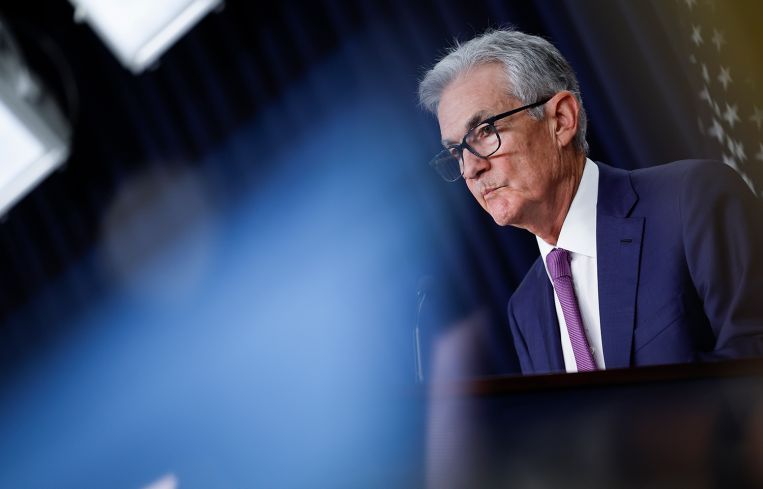Fed Pauses Interest Rates for Fifth Straight Meeting, But Maintains Three 2024 Cuts
By Andrew Coen March 20, 2024 3:53 pm
reprints
Commercial real estate transaction activity will likely remain in a holding pattern after the Federal Reserve stayed the course with its ‘higher for longer’ interest rate policy Wednesday, with a pause for its fifth consecutive meeting. The central bank did, however, offer some hope for the future by maintaining its outlook for three cuts in 2024.
The Fed, as expected, kept its benchmark interest rate at between 5.25 percent and 5.5 percent while also indicating cuts will not be on the table until there is more progress toward its 2 percent inflation target.
“We believe that our policy rate is likely at its peak for this tightening cycle and that if the economy evolves broadly as expected, it will likely be appropriate to begin dialing back policy restraint at some point this year,” Fed Chairman Jerome Powell said in a post-meeting press conference. “The economic outlook is uncertain however, and we remain highly attentive to inflation risks. We are prepared to maintain the current target range for the federal funds rate for longer if appropriate.”
The five pauses, going back to September, come on the heels of the central bank hiking rates in 11 of 12 sessions from March 2022 to July 2023, actions that brought borrowing costs to their highest level in 22 years. While core inflation measures have seen an uptick since the central bank’s January meeting, three interest rate cuts were still penciled in for 2024, with Powell stressing that a measured approach will be taken depending on economic trends.
“We know that reducing policy restraint too soon or too much could result in a reversal of the progress we have seen on inflation and ultimately require even tighter policy to get inflation back to 2 percent,” Powell said. “At the same time, reducing policy restraint too late or too little could unduly weaken economic activity and employment.”
Powell said if the economy moves as projected, Fed participants are projecting a median long-term federal funds rate of 4.6 percent at the end of 2024, 3.9 percent at the end of 2025 and 3.1 percent at the close of 2026.
The continuation of paused interest rates has given the CRE industry a reality check. Many Fed watchers saw brief signs of hope in the Fed’s December meeting when it forecasted three cuts in 2024, with much of Wall Street pricing in up to half a dozen cuts for this year.
“We started the year thinking that we would see as many as six rate cuts, and I think many would be quite happy with one or two at this point,” Lisa Pendergast, executive director at the Commercial Real Estate Finance Council, said before the Fed’s meeting “This is one of the more challenging and uncertain environments I’ve been in, and I have been in the market since 1983.”
The timing of the three predicted cuts still remains up in the air.
As the rising interest rate environment’s strain continues to place pressure on refinances, Pendergast said lenders from the commercial mortgage-backed securities (CMBS) market she tracks closely are generally receptive to extending loans scheduled to mature this year even for struggling assets like office buildings if borrowers commit more of an investment. Despite many headwinds facing CRE properties in the last few years, Pendergast noted that the delinquency rate in the CMBS market is only around 5 percent compared to double digits during the Global Financial Crisis, which she attributes to more conservative underwriting standards and more willingness to grant loan extensions.
Kristen Fallon, a partner in the real estate practice at Nixon Peabody in Boston, said the continued high interest rate environment is resulting in very few loans for the lender clients she counsels unless there are affordable housing tax credits associated with the project. Fallon, who mostly works with the nation’s largest CRE bank lenders, said clients are remaining largely on the sidelines.
“The only deals Nixon’s really seeing are in the acquisition or the disposition side, and most of the financing is cash,” Fallon said. “The overarching view I have been hearing at least from the top down within those [banks] was we’re pretending we can lend and we’re sort of chatting with clients as though we can, but we can’t.”
Fallon added that while some of the bigger financial institutions are exploring joint venture equity transactions to add to the capital stack, finding the right partner can be a barrier to adding this component to deals.
Looming debt maturities could however serve as a catalyst for spurring more forced CRE transaction activity, according to Fallon, who noted that many banks holding onto distressed debt will want to sell properties at a discount. She stressed that the 2024 maturities will likely earn extensions, but those that matured in 2022 or 2023 after interest rates began spiking are most endangered since they are losing their grace period from a regulatory perspective with banks.
“I do think, sprinkled throughout the second half of this year, that is going to start to be the driver of the rightsizing,” Fallon said. “Maybe then we’re going to start to see buyers and sellers meet and some money start to shake loose and be redeployable from the larger banks.”
Tara Darling, a shareholder in law firm Polsinelli who works in its real estate finance practice group, said many borrowers and lenders she counsels are seeking out preferred equity or mezzanine financing due to stricter underwriting standards for senior loans with loan-to-value ratios typically in the 60 to 65 percent range.
Darling, who primarily focuses on multifamily transactions, said there has been a particular uptick in preferred equity requests since it is often easier to execute in a deal than bringing in a mezzanine lender. This trend has particularly played out among agency lenders who want to avoid having to take back the keys on distressed properties.
“They aren’t in the business of running and owning properties, so we have seen a lot of these agency lenders either creating or further developing their preferred equity platform,” Darling said. “Sometimes that’s where an agency lender may be able to provide a preferred equity investment into the deal or in other scenarios using their relationships in the market to introduce their sponsors to preferred equity investors that are looking to invest in these deals.”
With preferred equity investments expected to pick up steam as interest rates remain higher for longer, Darling stressed the importance of being well-versed in what senior lenders are requiring given the complex nature of many of these transactions.
Erik Rutter, managing partner of Miami-based Oak Row Equities, said that while multiple interest rate cuts this year would be helpful from a borrower perspective, Secured Overnight Financing Rate (SOFR) floors required by lenders may limit the benefit.
“Rate cuts would definitely be beneficial for all borrowers out there and hopefully help free up some of the capital in the capital markets on both the debt and the equity side and help investment sales pick up and maybe we start to see where cap rates are,” Rutter said. “But because there’s a floor on for most of the lenders on SOFR once you’re going to get into that really impactful area, the floor is going to kick in and it will prevent you from getting the full benefits of the rate cuts.”
Despite the challenges of higher interest rates, Rutter secured a $181 million construction loan this month from Bank OZK for a planned 41-story office and apartment tower in Miami’s Edgewater neighborhood at 2600 Biscayne Boulevard. Rutter remains focused on opportunistically targeting certain assets throughout South Florida mainly in the multifamily space and does not have any loans coming due that will require extensions from past investments.
The persistent higher interest rate environment is opening opportunities to alternative lenders, as many banks are expected to remain on the sidelines this year. Nitin Chexal, CEO of Palladius Capital Management, said deal volume remained busy in 2023, and so far in 2024 inbound loan requests have doubled compared to this time a year ago. Many borrowers are seeking creative solutions to bring deals across the finish line like blending senior debt and preferred equity together, he said.
“It’s incumbent upon smart debt funds to be thoughtful about what are the right opportunities, and what are the opportunities that can’t be saved, and how can you help borrowers in this environment,” Chexal said. “Sometimes you have strong borrowers with good assets but they have bad capital structures, so the key is finding out how to help them solve a bad capital structure problem and buy them time to maneuver to a better environment.”
Andrew Coen can be reached at acoen@commercialobserver.com.


